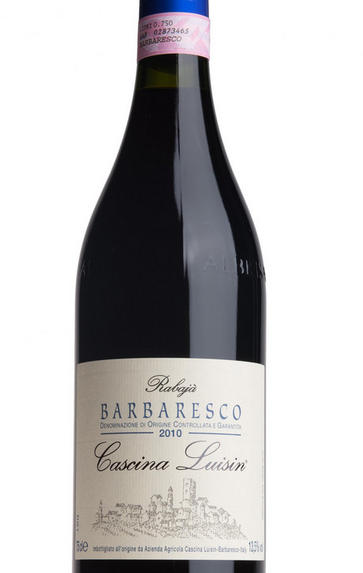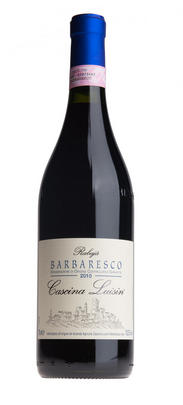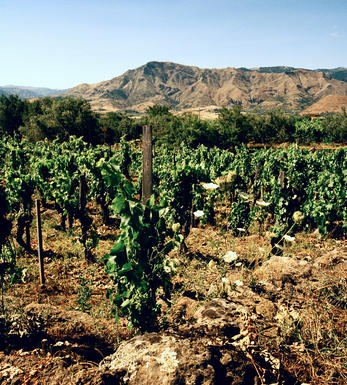
2010 Barbaresco, Rabajà, Cascina Luisin, Piedmont, Italy

About this WINE

Cascina Luisin, Piedmont
Cascina Luisin is a traditional family wine estate in Barbaresco, Piedmont, founded in 1913 by Luigi Minuto (‘Luisin’ means ‘small Luigi’ in dialect). It comprises 7ha of predominantly old vineyards, 50% of which grow Nebbiolo, notably Sori Paolin in Neive, Rabajà and Asili in Barbaresco itself; total production is approx. 30,000 bts per anno (incl. some Dolcetto, Barbera, Langhe Nebbiolo and Roero Arneis)
The estate is currently run by Luigi Minuto and his son Roberto (pictured right); the latter joining in 1995 from viticultural school. Despite buying a pair of rotofermentors soon after, Roberto conducted a trial of different fermentations (roto, cement, wood) and decided from that moment on to only ferment and macerate Nebbiolo for an extended period in cement to ensure stable wine and tannins, followed by a couple of years in large oak.
The rotofermentors are only used for Dolcetto and Barbera, saving time. In 1998 he also stopped fining, filtering, using selected yeast and applied only natural manure. More recently he has been replacing the oldest large slavonian botte with new Stockinger botte. Bottling is done when the wine is ready.
Their soft Barbaresco Sori Paolin reflects the sandy soils of Neive; Barbaresco Rabajà (overwhich the cantina looks) is more muscular thanks to its predominantly western exposure; while Barbaresco Asili (from vintage 2011) is all about red-fruited finezza.

Barbaresco
The Piedmontese DOCG zone of Barbaresco is responsible for producing some of Italy’s finest wines. It occupies the same region and uses the same grape (Nebbiolo) as its bigger brother Barolo, but is a third of the size (only 640 hectares versus Barolo’s 1,700 hectares). It is also 50 years younger than Barolo, having produced wine labelled Barbaresco since 1890.
Barbaresco earned its DOCG after Barolo in 1980, largely thanks to the efforts of Angelo Gaja. The soils are lighter here than in Barolo – both in colour and weight – and more calcareous. The slopes are also less favourably situated and (relatively speaking) yield earlier-maturing yet extremely elegant wines that require less oak ageing (normally one year in oak plus six months in bottle). The appellation’s key districts are Barbaresco, Treiso, Neive and Alba.
Recommended producers: Cigliuti, Gaja, Marchesi di Gresy

Nebbiolo
Nebbiolo is the grape behind the Barolo and Barbaresco wines and is hardly ever seen outside the confines of Piedmont. It takes its name from "nebbia" which is Italian for fog, a frequent phenomenon in the region.
A notoriously pernickety grape, it requires sheltered south-facing sites and performs best on the well-drained calcareous marls to the north and south of Alba in the DOCG zones of Barbaresco and Barolo.
Langhe Nebbiolo is effectively the ‘second wine’ of Piedmont’s great Barolo & Barbarescos. This DOC is the only way Langhe producers can declassify their Barolo or Barbaresco fruit or wines to make an early-drinking style. Unlike Nebbiolo d’Alba, Langhe Nebbiolo can be cut with 15% other red indigenous varieties, such as Barbera or Dolcetto.
Nebbiolo flowers early and ripens late, so a long hang time, producing high levels of sugar, acidity and tannins; the challenge being to harvest the fruit with these three elements ripe and in balance. The best Barolos and Barbarescos are perfumed with aromas of tar, rose, mint, chocolate, liquorice and truffles. They age brilliantly and the very best need ten years to show at their best.


Buying options
Add to wishlist
Description
Compared to the sandier site of Sori Paolin, Rabajà is very much a vineyard that owes its presence and firmer structure to the village of Barbaresco. Cooler, calcareous clay combines with a hot west-facing exposure to give a kirsch like character to the red-berried fruit. It’s seems deeper rooted and more cool mineral than the soft cage fruit of Sori Paolin. There’s a distinct ‘iron fist in velvet glove’ character to 2010 Rabajà, along with brambly warmth. Needs time.
David Berry Green
wine at a glance
Delivery and quality guarantee